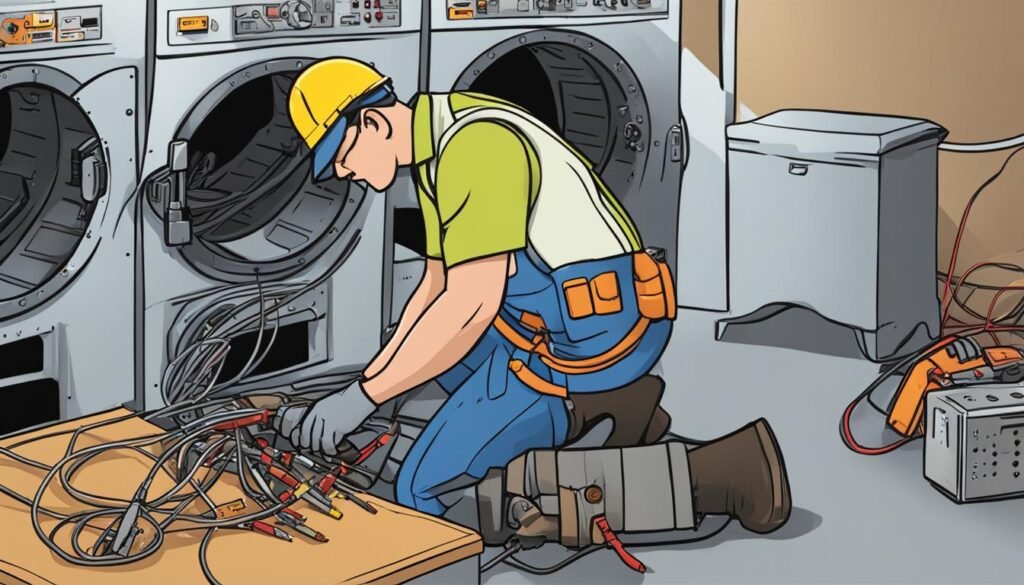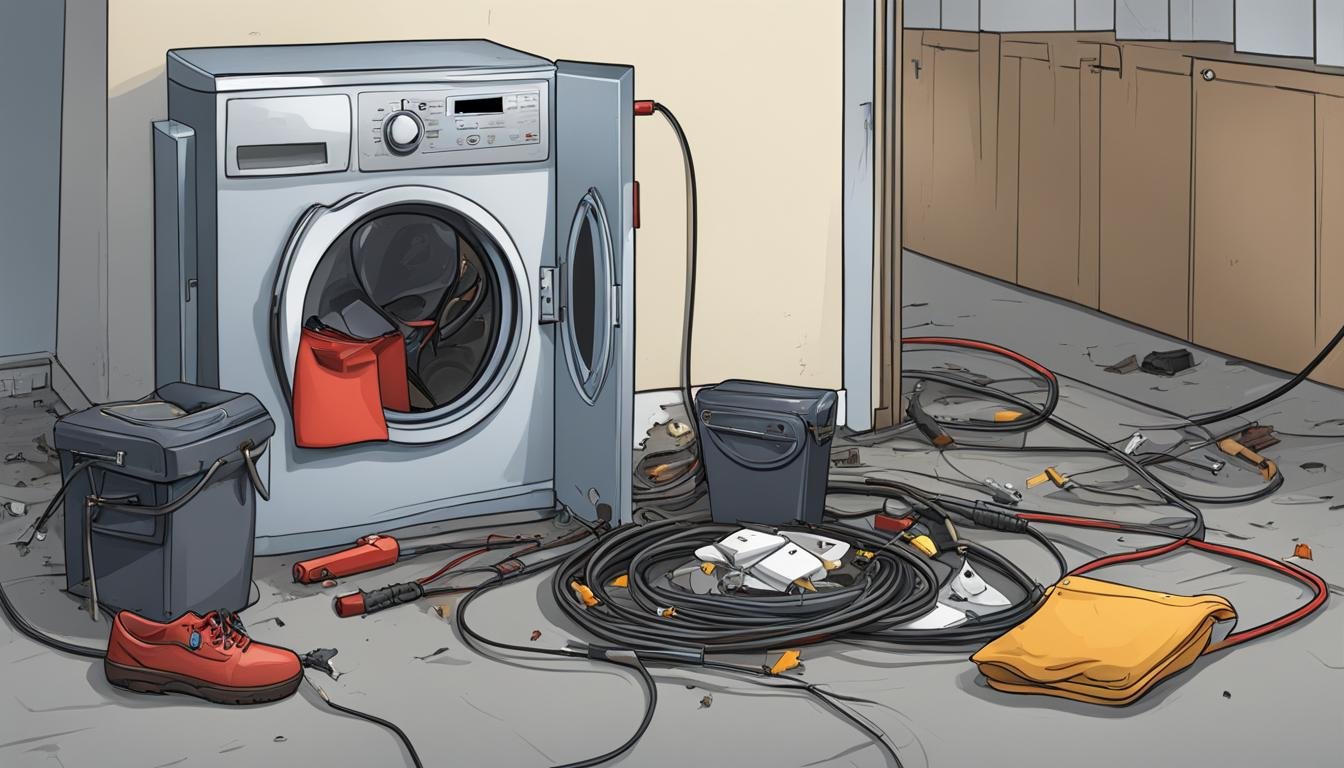If your dryer keeps tripping the breaker, it can be frustrating and inconvenient. But don’t worry, there are several potential reasons behind this issue, and in this article, we will help you troubleshoot and find a solution.
It’s essential to understand that a dryer tripping the breaker can be caused by various factors, such as a faulty heating element, drive motor problems, loose connections in the terminal block, or even a worn-out circuit breaker. By properly diagnosing the problem, you can take the necessary steps to fix it and prevent any further disruptions to your laundry routine.
Key Takeaways:
- Check the heating element: A faulty or shorting out heating element could be the culprit.
- Test the drive motor: A faulty drive motor can also cause the breaker to trip repeatedly.
- Inspect the terminal block: Loose connections or arcing in the terminal block can lead to tripping issues.
- Consider replacing the circuit breaker: If all else seems fine, the circuit breaker itself might be the problem.
- Seek professional assistance if needed: If you’re unsure or unable to diagnose the problem, it’s best to consult a professional electrician for safety and proper repair.
Checking the Heating Element
If your dryer keeps tripping the breaker, one possible culprit could be a faulty heating element. The heating element is responsible for generating the heat needed to dry your clothes. Over time, it can wear out or develop a short circuit, causing it to trip the breaker.
To check the heating element, you should first ensure that the power to the dryer is turned off. Safety should always be your top priority when working with electrical appliances. Once the power is off, locate the heating element within the dryer. It is usually housed behind the front or rear panel, depending on the model.
Now, using a multimeter set to the continuity mode, carefully test the heating element for continuity. This test will determine if there is a continuous path for electricity to flow through the heating element. If there is no continuity, it indicates that the heating element is faulty and needs to be replaced.
Replacement
If you have determined that the heating element is the source of the problem, it is time to replace it. Fortunately, replacing a dryer heating element is a relatively straightforward process. However, it is recommended to consult your dryer’s manual or seek professional assistance to ensure the correct replacement part is used and the installation is done safely.
Remember, always prioritize your safety and follow proper electrical safety protocols when working on your dryer. By checking and replacing the faulty heating element, you can resolve the issue of your dryer tripping the breaker and get back to smooth, uninterrupted laundry days.
Testing the Drive Motor
If your electric dryer keeps tripping the breaker, a faulty drive motor could be the culprit. The drive motor is responsible for spinning the drum and operating the various components of the dryer. A malfunctioning motor can cause an overload on the electrical circuit, leading to the breaker tripping.
To test the drive motor, first, ensure that the power to the dryer is turned off. Locate the motor, which is typically located at the back of the dryer, near the drum. Use a multimeter to test for continuity in the motor.
If the multimeter shows no continuity, it means that the motor is faulty and needs to be replaced. A lack of continuity indicates that there is a break in the electrical path, preventing the motor from functioning properly. It is best to consult a professional technician or an electrician to replace the drive motor, as it requires expertise and specialized tools.
Fixing the issue with the drive motor can help prevent your dryer from tripping the breaker and ensure smooth and efficient operation. By identifying and addressing the problem, you can avoid potential hazards and extend the lifespan of your dryer.
Checking the Terminal Block
One of the common causes of a dryer tripping the breaker is a loose connection or arcing in the terminal block. The terminal block is where the power cord connects to the dryer’s wiring. Over time, these connections may become loose, leading to a poor electrical connection and potentially causing the breaker to trip.
To check the terminal block, first, ensure that the power to the dryer is turned off. Then, carefully inspect the terminal block for any loose or damaged wires. Tighten any loose connections using a screwdriver, and replace any damaged wires if necessary. It is crucial to make sure that all the connections are secure and properly tightened to prevent further tripping of the breaker.
In addition to loose connections, arcing can also occur in the terminal block, causing intermittent electrical shorts. Look for any signs of arcing, such as blackened or charred marks. If you notice any arcing, it is recommended to replace the terminal block altogether.

Prevent Dryer from Tripping Breaker
To prevent your dryer from tripping the breaker in the future, there are a few steps you can take. Firstly, ensure that the dryer is properly installed and grounded. A grounded outlet and wiring will help to provide a stable electrical connection and reduce the risk of tripping the breaker.
Regularly inspect and clean the dryer’s venting system to prevent lint buildup. Excessive lint can restrict airflow, causing the dryer to overheat and potentially trip the breaker. It is also essential to follow the manufacturer’s instructions for load capacity, as overloaded dryers can put strain on the electrical system and lead to breaker trips.
If your dryer continues to trip the breaker after checking the terminal block and taking preventive measures, it is advisable to consult a professional electrician. They can help diagnose and resolve any underlying electrical issues and ensure the safe and reliable operation of your dryer.
Replace the Circuit Breaker
If all the components mentioned above appear to be working fine, the issue might be with the circuit breaker itself. Over time, circuit breakers can wear out and trip repeatedly. When a circuit breaker becomes worn out, it becomes less reliable in detecting electrical faults and protecting your dryer from potential hazards.
To address this problem, it is essential to replace the faulty circuit breaker. However, it is crucial to have a professional electrician handle this task to ensure it is done safely and correctly. Electricians have the necessary expertise and tools to replace a circuit breaker without risking electrical accidents or damage to your dryer.
Why Hire a Professional Electrician for Circuit Breaker Replacement?
Replacing a circuit breaker may seem like a straightforward task, but it involves working with electrical connections and systems. Hiring a professional electrician offers the following benefits:
- Expertise: Electricians have in-depth knowledge and experience in handling electrical systems, including circuit breaker replacement.
- Safety: Electricians prioritize safety and are trained to follow all necessary safety protocols during circuit breaker replacement.
- Proper Equipment: Electricians have the right tools and equipment to safely replace a circuit breaker without causing damage or hazards.
By hiring a professional electrician, you can ensure that your circuit breaker replacement is done correctly, minimizing the risk of electrical issues and ensuring the continued safe operation of your dryer.
Remember, if you’re experiencing issues with your dryer tripping the circuit breaker, it’s always best to consult a professional electrician. They can accurately diagnose the problem and provide the right solution, ensuring your dryer operates safely and efficiently.
Conclusion
To prevent your dryer from repeatedly tripping the breaker, it is crucial to address the underlying issues. Common culprits include faulty heating elements, drive motors, loose connections, or worn-out circuit breakers. By troubleshooting and fixing these specific problems, you can ensure the safe and efficient operation of your dryer.
If you are not confident in diagnosing and resolving the problem yourself, it is always recommended to seek the assistance of a professional electrician. They have the necessary expertise to identify the root cause and carry out the necessary repairs.
Remember, maintaining a functional dryer is essential for your laundry routine. So, take the necessary steps to prevent your dryer from tripping the breaker and enjoy hassle-free drying every time.
FAQ
Why does my dryer keep tripping the breaker?
There can be several reasons behind this issue, including a faulty heating element, a drive motor problem, a loose connection in the terminal block, or a worn-out circuit breaker. It is important to properly diagnose the problem to find the right solution.
How do I check the heating element?
To check the heating element, make sure the power is turned off, locate the heating element, and use a multimeter to test for continuity. If there is no continuity, the heating element needs to be replaced.
What can cause the dryer to continuously trip the breaker?
A faulty drive motor can cause the dryer to continuously trip the breaker. To test the drive motor, ensure the power is off, locate the motor, and use a multimeter to test for continuity. If the motor does not have continuity, it needs to be replaced.
How do I check the terminal block?
Inspect the terminal block for loose wires and any signs of arcing. Tighten any loose connections and replace any damaged wires if necessary.
What should I do if none of the components seem to be the issue?
If all the components mentioned above appear to be working fine, the issue might be with the circuit breaker itself. Over time, circuit breakers can wear out and trip repeatedly. Replacing a circuit breaker should be done by a professional electrician.
How can I prevent my dryer from repeatedly tripping the breaker?
Troubleshoot and address the specific issue causing the tripping to prevent it from happening again. If you are unsure or unable to diagnose the problem, it is always recommended to seek the assistance of a professional electrician to ensure safety and proper repair.

